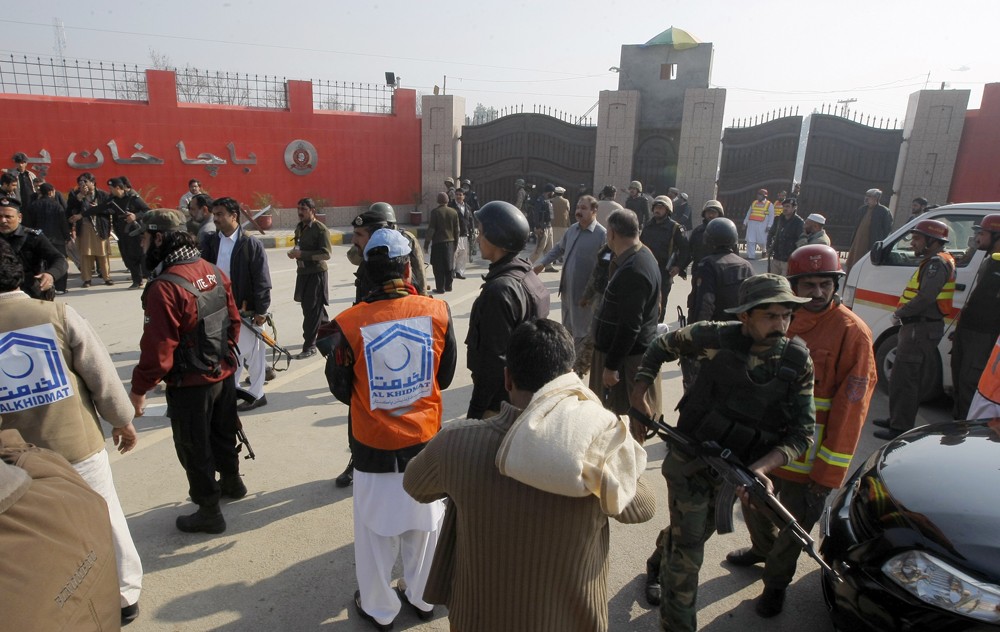
We must carry on with caution but without fear; this shall probably inflict the severest blows on terrorists

The tragic loss of 21 lives in the Bacha Khan University terror attack shows that there is a dire need to reconsider campus safety arrangements. Different observations are cited by stakeholders on this situation. A few think that the provincial government in KP has casually responded to the possibilities of terror strikes on educational institutions.
Some lament the fact that after a few days of every incident, things return to normal across the country. It is also assumed that security and safety provisions are the responsibilities of law enforcement agencies. The reality, however, is quite different.
The situation requires a befitting response from all institutions, parents, guardians, and students. Campuses and institutional spaces have to be protected through a long-term scientifically prepared strategy. If we have to rise above the ashes, a resolute stand and coherent collective action is needed from all concerned. Some references are made below for the consideration of the concerned quarters.
Educational institutions will have to include security as a management pre-requisite. This will include the review of threat possibilities, available resources for ensuring preparedness and practical actions for maintaining the protection of all concerned.
A scientific way to combat this challenge is to acquire the input of experts on this subject. This may be possible for large integrated chains of schools, colleges, and universities. The government-run institutions may also ask the government to facilitate this vital need.
Failing agencies, such as civil defence, must be revived to fulfill this most essential task. However, there are many steps that can be taken instantly. Every institution must constitute a small committee of senior teachers and administrative staff for reviewing the security situation. They may document common matters, such as traffic circulation, parking and storage of bulk items within the premises.
The hidden spaces with a possibility of hiding saboteurs and terror objects must be regularly checked. Every institution has watchmen and peons. They are the first line of security. Appropriate training must be provided to them from relevant government institutions. They may also be trained to keep a focused watch on suspicious elements.
A study on the pattern of terror attacks can also help in shoring up the internal and external arrangements. Senior staff and heads of institutions must make security as a priority of their responsibilities. Information gathering, access and interface with area police are some mentions. The Punjab police have outlined several basics which can become the starting point.
The next vital stakeholders are parents and guardians. They can bring a sizable difference in lifting up security arrangements. In schools, where parent-teacher associations exist, the bodies can join hands with the management to review and respond to challenges.
Simple moves can make worthwhile improvements. School boundary walls can be kept clear of passers-by. Where school vans are employed for transporting pupils, vehicle operators must be trained for managing security of their vans and buses. They should not be left unattended. The drivers should not allow any unknown person to take a lift under any circumstances.
Care must be taken to obtain CNICs and other information about operators and cleaners. School and college managements with parent bodies must make this extra effort to work on this count for mutual safety and security. Stock-taking of hawkers and street vendors must be done in the same manner.
Without infringing on the basic rights and livelihoods, a simple information collection and monitoring can bolster the security of all concerned to a considerable extent. Parents may also horizontally interact and liaise with each other. Watching over rumours and enhancing communication are some of the key attributes of mutual interaction. Contacts and networks of parents can be greatly useful for the benefit of institutions.
Depending upon their age, profile and type of institution, students have varied tasks ahead of them. Small children need to be supervised. The onus lies upon teachers, school managements and parents. Scale of preparedness for emergencies can be regularly examined by fire drills, mock emergency evacuations and the ability to respond to such calls.
Grown up students can become participants in this trying episode. Identifying any kind of suspicious folks or activities, remaining vigilant about props and belongings in the school/college and following instructions of managements are the minimum expected from them.
At the university level, this responsibility stretches further. The campuses are porous entities in many instances. Students have the greatest outreach in terms of movement and observation. They can link up with respective student affair offices and security wardens to check incursion points and desolated areas. They can also prevent strangers and trespassers from mingling among them in and around canteens, stationery shops or other congregation points.
Campus mosques are also a space which needs to be monitored. Only staff on the payroll of universities must be allowed to manage them. All kinds of visitors without any reason to attend such spaces must be strictly prohibited. The same convention must apply to other public places.
It will be appropriate if the government interacts with student wings of political parties for exchanging views and taking them on board in the security management exercises. Utmost care is needed to monitor hostels which have historically been used for harbouring anti-social elements.
Universities must revisit the watch and ward guidelines and codes of conduct for students. One of the ways is to encourage ordinary students to inform the management with confidence. A way of anonymous complaint recording and redress must be worked out.
By devising the means of self protection, mutual safety and surveillance, terrorists’ designs can be defeated. We must carry on with our assigned tasks with caution but without fear. This shall probably inflict the severest blows on the terror planners.